Hanga Kites
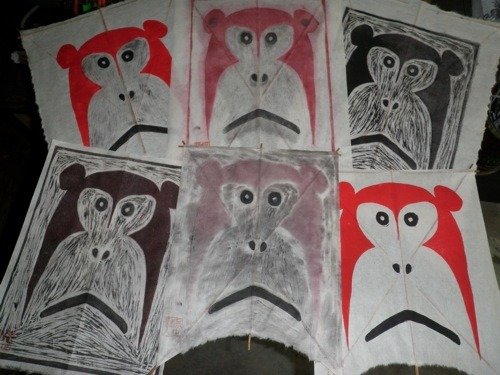
Stop "monkey"-ing around… Start your carving! There is still time to get your hanga print to us by our January 15th deadline.
Best of show and two runner up gift certificates from McClains and Hiromi Paper will be awarded. A catalog of chosen works will be produced for all the USA exhibition sites.
Join the fun! View contest rules and download an entry form here.

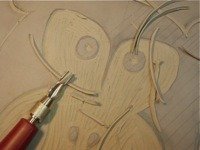
Kites and photos by Jose Sainz
Wisdom & Inspiration Within the Lee Toy Archives
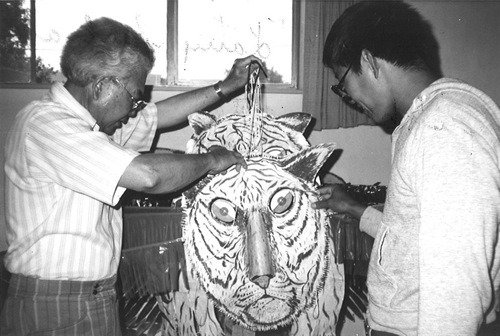
A young man enthralled. Caption on back of photograph, "Larry explains tiger centipede to Leland." Courtesy of the Toy Family.
When Lee Toy found out he was HIV positive on November 1st, 1988, he wrote in his kite sketchbook a few days later, "With HIV+ status life has more meaning to [the] extent of getting on with what we think is important. No time [for] bullshit – yet insight to many life issues – change the things we can – positive thinking." These frank, sage words are embedded deep within a book that he clearly held close. Full of drawings, notes, and clippings the sketchbook is one gem among many in his archive, which is highlighted here. In 2005 the Drachen Foundation was the recipient of six boxes of remaining records from his life of kiting and beyond.
Included in the archive is a nearly complete set of his Kite Flyer newsletters (see below for available issues). Lee started the bimonthly kiting newsletter with Paul Walker in 1978, and while Paul left the endeavor, Lee kept publishing until 1985. Widely read among many in the kiting community, he infused his charm into information on local kiting events, kite people, and whimsical illustrations that brought the stories and kite plans to life. "It was a down-home production," he said. "But because there wasn’t much kite news available then, it started to circulate nationally. A subscription cost $5. When one came in, I went right down to the Doggie Diner—the $5 was dinner."
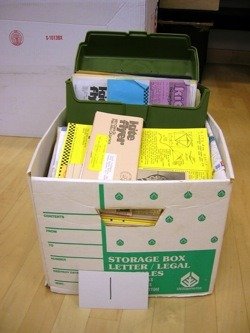
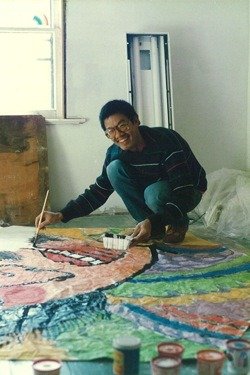
Above left: A box from the Lee Toy archive before processing. Taken by Alison Fujino. Above right: Lee painting a Rokkaku kite. Courtesy of the Toy Family.
Lee was given the label of "kite vagabond," after he spent 18 months in 1982-1983 travelling the country on his motorcycle, "Snail," to spend time with other kite people and learn their ways. This kite vision quest gave him fodder for Kite Flyer writing (he published from borrowed typewriters on the road), enhanced his artistic inspiration and kitemaking abilities, and allowed him to meet so many of the people who knew him only through the colorful pages of Kite Flyer. One product of the trip was a kitemaking instruction booklet Flight Patterns, published in 1984. It was an accompaniment to a kitemaking series produced by WVPT-TV in Harrisonburg, Virginia, whom he became connected with through his travels. "The wide world of kites lies at your feet waiting to be explored," he wrote in his introduction. "Flight Patterns is just one of the keys to unlock the door."
A Chinese-American who wore large red-frame glasses, one can be easily charmed by his photograph alone. And though descriptions and memories of Lee show him to be fun-loving and easy-going, he was an important figure in the kite community for reasons beyond his charm. He was a serious student of kites and wanted them to be recognized as a professional endeavor and artform. Another discovery in his archive exemplifies this – his "Kite Flying Journal," written between 1978 and 1979. In the journal we are given a look at his meticulous and more in-depth study of kite making and flying. He sets out a way to both record and analyze the success of each kite he flies, or those he observes others’ flying on the Marina Green in San Francisco. It reads,
"Each day of flight will be listed along with the following information: 1. Wind conditions & weather & location 2. Type of kite flown & dimensions (in inches + cm) 3. Length of line & type 4. Reel type 5. Flight characteristics & general comment a. angle of flight using a measuring device see insert b. altitude see insert for calculations c. corrections & adjustments for successful flight. tail, bridal, bow, balance."
While extremely valuable in understanding Lee Toy, the archive, which was his personal property, is still a fairly one-sided story. How has Lee influenced kite culture and how does his legacy live on now? His legacy is carried strongly through the kite community by the people who knew and loved him, but his influences to individuals are sometimes more subtle, working their way into kites or conversations. Kitemaker and Rokkaku fighter Ronda Brewer writes on her website, "The first kite I painted and made was because of Leland Toy. He was to teach a class on Samauri Face Painting at the 1990 Fort Worden Kitemakers Conference and I thought the class sounded interesting. So, I signed up for it. I did not know anything about Lee or what a Rokkaku kite was. It turned out to be a life altering experience."

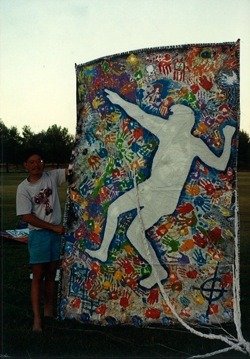
Above left: Lee and his brother Philip with a kite Lee made for a KLOK radio contest in San Francisco. He won First Prize and a trip to Hawaii. Courtesy of the Toy Family. Above right: Lee with his "Healing Kite of Hands."
In 1998, the AKA decided to recognize Lee as a major influence for kite artists and introduced the Lee Toy Memorial Kite Artist of the Year Award, presented annually at the AKA Convention. The first winner of the award was Scott Skinner in 1998, and most recently in Seaside Oregon this year, Dave and Diane Butler. Each year a team of judges, including the past winner, look for a kite artist that exemplifies the character of Lee Toy. The AKA states,
"The Kite Artist of the Year recognizes an artist’s body of original work or their commitment to kites as art as well as their ability to inspire others in recognizing the uniqueness of kites as art. The Artist of the Year demonstrates a willingness to teach, explore and innovate in promoting kites within the AKA membership or the broader community. The recipient also shows a clear generosity of spirit and willingness to share his or her energies in promoting kites as an art form."
Leland Toy died in December 1992, at the young age of 42. Exploring the personality and legacy of this man through his archive gave me an intimate glimpse into the life of a kitemaker, artist and writer who influenced kite culture internationally and is remembered fondly by so many. Scott Skinner wrote after he received the award, "Lee’s good humor, empathy, and encouraging personality did as much as his work to inspire the best from every person he met." For those of us who did not have the privilege of meeting him, seeing his kites and reading his remaining words still provides powerful inspiration.
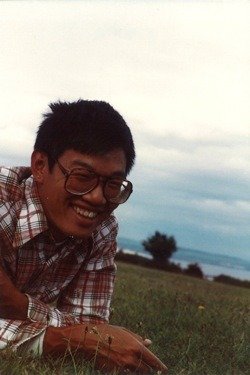
My favorite picture. Taken by Jack Van Gilder, August 1982.
See below for links to full-pdf versions of the Kite Flyer newsletter issues, an illustrated kite journal and a kite sketchbook. Please take a closer look, the collection as a whole draws a beautiful portrait of an important kite personality.
Kite Flyer newsletters, 1978 – 1985 (PDFs)
2010-11-L-1552 through 2010-11-L-1559 1978
Handwritten and illustrated kite flying journal from 1978 – 1979 (PDF)
2010-11-A-00486
Near daily entries with many illustrations.
Kite flying and personal sketchbook from 1988 – 1991. (PDF)
2010-11-A-00487
Near daily entries with paintings, illustrations, diagrams, notes, and personal entries.
Take a look at all the Lee Toy kites in the DF collection and read Flight Patterns, still distributed by the Toy family and available for purchase, all on the DF website.
References:
AKA Award Criteria http://www.aka.kite.org/resources/publications/cat_view/134-main/131-organizational/125-awards-criteria
Brewer, Ronda. "Tyvek Painting Tips" http://www.kitesinthesky.net/resources/tyvek-painting-tips.php
Drachen Design, Inc. "1991 Kite Pin Invitational: Leland Toy." 1991.
Govig, Val. "Empty Spaces in the Sky: Leland Toy." Kite Lines. Spring 1993.
Toy, Lee. Flight Patterns. Sky High Press, Scottsdale. 1984.
New Issue of Discourse
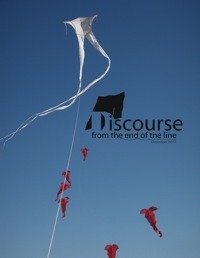
Drachen Foundation announces the ninth issue of our publication, Discourse: from the end of the line. In this installment, kite aerial photography from Mexico, an interview with Carl Robertshaw, and more…
Click here to open the PDF.

